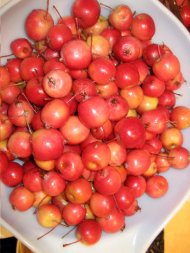
Looking through my collection of custard tart recipes I found this traditional South African recipe and adapted it by adding the last of my dried local chestnuts and soaking them in rum, to celebrate the end of the harvest season, and to kick-start the holiday season. This tart is deliciously creamy and ideal for the festive, cold winter months.
The generous covering of cinnamon sugar on the top combined with the boozy richness of a bottom layer of halved, rum-soaked chestnuts, and the filling of vanilla-infused custard makes a tart that should get a first-place vote from every family member (if the varied tastes of my family are anything to go by!). Made with a gluten-free crust which holds up fantastically when cut, and lasts for up to 1 week in the fridge, this recipe will endure the festive week around Christmas when other favourite goodies compete for a place on the dessert plates.
Note 1: the filling will fill a 22 cm (9") spring-form tin as well as a little cake tin on the side (nice for sampling before tucking in to the actual tart!
Note 2: Leave a good 2 hours for the creation of this dessert; it is well worth the care and attention.
5 tbsps rum
400ml Double cream
1/2 of 1 vanilla pod, split lengthways
50g unsalted butter
4 eggs, separated
100g granulated sugar
Chestnuts: 2 small handfulls of pre-boiled and peeled chestnuts
2 tbsps of gluten free flour mixture (10ml each of potato starch, tapioca starch and white rice flour)
2 tbsps of cornstarch / cornflour
2 tsp cinnamon
75g brown sugar with no lumps
To allow for maximum rum absorption, break the chestnuts into halves and place in a shallow container that can just barely contain the chestnuts in 1 shallow layer and spoon over 3 tablespoons of rum. Leave to soak until their use at the very end of the recipe.
For the Gluten free Pastry:
1 egg
75g unsalted butter at room temperature
75g icing sugar
In a food processor combine the cubed butter, icing sugar and egg. In a bowl stir the flours together with the xanthan gum and add to the butter mixture.
75g tapioca starch
50g potato starch
125g white rice flour
1/2 tsp xanthan gum
Pulse until the pastry forms a ball. Flatten the dough into a disc and wrap in plastic wrap to chill in the fridge for at least 30 minutes. This can be made ahead of time and left in the fridge until required.
Place the disc of dough between two pieces of plastic wrap and roll out. The dough may be resistant to stretching but keep rolling until you reach a thickness of roughly an 1/8th of an inch. Drape the dough over a 20-22cm spring-form/loose-bottomed cake tin. You may have to patch the dough a little around the sides and top edges but rest assured it will look great in the end. You can even leave the top edge looking uneven which adds to the character -making it a little more rustic looking; just be sure to keep the sides quite high- you want the dough coming up to at least 2cm from the top of the springform tin. Prick the base with a fork and chill for 15 minutes. Preheat the oven to 190°C.
While the pastry is chilling put the cream in a pan with the butter and half the vanilla pod. Bring to a boil, then quickly remove from the heat, and leave the mixture to infuse.
Remove the pastry from the fridge and prepare to weight the pastry for baking. Cut enough parchment paper so that it will cover the base of the pastry and so that it can be filled with baking beans (I use rice grains which is often a cheaper option than buying baking beans). Try to evenly distribute the weight so that it reaches the outer edges of the pastry base to prevent rising.
Bake the pastry for 10 minutes and remove paper and baking beans/rice. If the fork marks reveal the tin base then brush the pastry with a beaten egg to help seal it. If given the egg-wash treatment then return the pastry to the oven for a further 10 minutes.
While the pastry is baking whisk together the egg yolks and the sugar, then whisk in the flour mixture and the cornstarch. Sieve the heated cream into the egg yolks and stir, then return mixture to the pan to cook on a low heat for several minutes, stirring the entire time until the custard thickens*, then remove from the heat.
Add the rum to the custard and stir. Place the rum-soaked chestnuts into the base of the pastry in a single layer (save any additional chestnuts for another use). Whisk the egg whites until they form soft peaks. Pour the custard on top of the egg whites and quickly fold together until just combined. Pour the custard mixture into the cake tin then sprinkle with a mixture of the brown sugar and cinnamon.
Bake the tart for 25 minutes at 190°C until set. When cooked there should still be a slight wobble in the middle. Leave the tart to cool before diving in.
*If the mixture heats for too long or is not constantly stirred then lumps will form. If this happens, then don’t worry, just strain the mixture through a sieve working it through with a wooden spoon. This does take time however, and may affect the end result, so is best avoided.
















